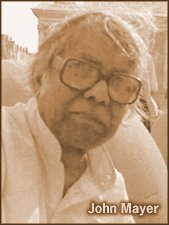[indo-jazz fusions] - [recordings] - [biography] - [reviews]
John Mayer : A Jazz Passage to India
Norman Weinstein - Pheonix Media 1997
 Is there any world-music tradition that hasn't received a jazz treatment? African drums, Indian sitars, even Siberian rattles -- they've all found their way into jazz sessions, with varying degrees of success. Trouble is, exotic tonal colors don't automatically create masterpieces. This has been particularly true with fusions of Indian music, so it's refreshing to discover John Mayer's Indo-Jazz Fusions with their new Nimbus release, Asian Airs. Rather than rely on an arcane recording site (such as Paul Horn at the Taj Mahal) or clever instrumental substitution (John McLaughlin's electric guitar as quasi-sitar), Mayer and his band -- who are based in Birmingham, England -- simply create compositions that are delicate balancing acts of Indian and jazz musical features.
Is there any world-music tradition that hasn't received a jazz treatment? African drums, Indian sitars, even Siberian rattles -- they've all found their way into jazz sessions, with varying degrees of success. Trouble is, exotic tonal colors don't automatically create masterpieces. This has been particularly true with fusions of Indian music, so it's refreshing to discover John Mayer's Indo-Jazz Fusions with their new Nimbus release, Asian Airs. Rather than rely on an arcane recording site (such as Paul Horn at the Taj Mahal) or clever instrumental substitution (John McLaughlin's electric guitar as quasi-sitar), Mayer and his band -- who are based in Birmingham, England -- simply create compositions that are delicate balancing acts of Indian and jazz musical features.
Mayer, a classically trained violinist who was born in Calcutta but is a long-time Brit, did this once before. During the 1960s Atlantic Records released two LPs (both now deleted) of music by Mayer's Double Quartet, the "Double" referring to the fact that half the players were jazzsters, the other half musicians on Indian instruments familiar with traditional Indian music. The star of those sessions was saxophonist Joe Harriott, one of the great obscure figures in Caribbean and European jazz history, whose smoldering alto cries gave a passionate edge to Mayer's fusion. Anna Brooks, Mayer's current saxophonist, doesn't possess as distinctive or fiery a voice as Harriott's but she executes logical solos that keep these pieces chugging.
What is startling -- and still somewhat beyond comprehension -- is how the jazz and Indian musical characteristics flicker in and out of prominence. Think of that visual puzzle where the eye initially views a vase outline. Blink. A drawing of an old hag magically appears, as if it had always been present, and the vase an illusion. Here is its musical equivalent. "Jhaptal," which runs less than two minutes, sounds like a sitar feature one moment, a jazzy dance with small Indian embellishments the next. "Mela" roars with feverish bop rhythms, yet culminates with a calmly lyrical and sinewy flute solo that sounds centuries old. The difficulties of cross-cultural fusion are legend, but anyone who wants to hear the rewards of doing it artfully must listen to this jazz passage to India and beyond.